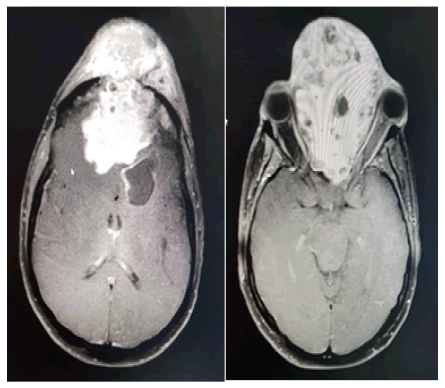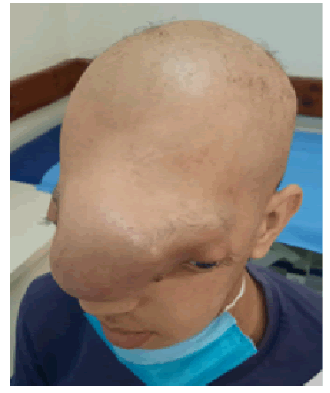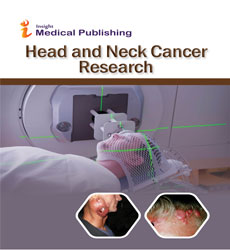Nasal Sinus Esthesioneuroblastoma: A Case Report
Mossé B.A. Wilfried, Patricia Agbanglanon, Seka Evrard N, Compaoré Bertrand, Kietga Gaêl, Siham Jaba, Benmessaoud Houda, Abdou Sara , Tayeb Kabdani, El Majjaoui Sana, Elkacemi Hanan and Nourddine Benjaafar
Wilfried MossÃ1*, Patricia Agbanglanon1, Compaoré Bertrand1, Kietga Gaêl1, Seka Evrard N1, Siham Jaba1, Benmessaoud Houda1, Abdou Sara1, Elkacemi Hanan1, Tayeb Kabdani1, El Majjaoui Sana1, Nourddine Benjaafar1
Department of radiation oncology, National institute of oncology, Mohamed V University, Rabat, Morocco
- *Corresponding Author:
- Mossé BA WilfriedDepartment of radiation oncology, National institute of oncology, Mohamed V University, Rabat, Morocco; E-mail: mossleboss2@gmail.com
Received Date: August 25, 2020; Accepted date: August 18, 2021; Published date: August 30, 2021
Citation: Mossà W (2021) Nasal sinus Esthesioneuroblastoma: a case report. Head Neck Cancer Res Vol.6 No.3.
Abstract
Esthesioneuroblastoma [ENB] is a rare malignant neoplasm originating from the olfactory epithelium located in the upper part of the nasal cavities. The treatment is not yet well codified; external surgery and radiotherapy were the standard treatment. We have reported a case of a 20-yearhold patient treated with neoadjuvant chemotherapy, surgery, and then adjuvant chemotherapy. The prognosis of these malignant tumors is similar to that of ethmoid adenocarcinomas and better than that of squamous carcinomas of the facial bone structure. 5-year overall and disease-free survival averaged 45%.
Introduction
Esthesioneuroblastoma [ENB] is a rare malignant neoplasm originating from the olfactory epithelium located in the upper part of the nasal cavities[1]. Molecular studies indicate that the basal progenitor cells of the olfactory epithelium are the cause of esthesioneuroblastoma. The histopathological diagnosis remains difficult and relies on the results of the expression of antigens detected through a panel of antibodies by immunohistochemistry [1]. The treatment is not yet well codified; external surgery and radiotherapy were the standard treatment. The use in recent years of endoscopic endo-nasal surgery and chemotherapy appears promising [2]. We report here a case of ENB treated with chemotherapy and surgery and which progressed during treatment.
Observation
A 20-year-old young boy with no prior medical history, presented to the hospital with nasal obstruction, epistaxis, and nasal swelling evolving for 05 months [figure 1]. A facial Magnetic Resonance Imaging showed a process of the nasal cavities and ethmoid cells of approximately 47x71x89 mm, fills the nasal cavities, ethmoid cells, and frontal sinuses infiltrate the ethmoid lamina and the crista Galli process with intimate contact with the frontal lobes. The biopsy with immunohistochemistry [the Anti-bodies: anti-GFAP negative, anti-Chromogranin A positive, anti-Synaptophysin positive, anti CD99 negative, anti-Cytokeratin positive and anti-Protein S-100 positive]] is in favor of an esthesioneuroblastoma. He was classed stage C of Kadish.
He received 03 courses of neoadjuvant chemotherapy based on cisplatin + Etoposide then operated [R2 excision] then 03 courses of adjuvant chemotherapy. The inter-course intervals were respected. Then referred for adjuvant Radiotherapy [Intensity Modulated Radiotherapy-IMRT]. The patient has progressed and the tumor invades the brain parenchyma [Figure 2]. He is then referred for palliative chemotherapy.
Discussion
Esthesioneuroblastoma was described for the first time by Berger and Luc in 1924 [3]. Less than 1000 cases in the world have been published during the last twenty years, with less than 1 case per million [4]. It is a rare and clinically variable malignant tumor of the nasal sinus and the base of the skull [5,6]. Symptoms of the tumor are related to its location and generally include: epistaxis, nasal obstruction, olfactory, and ophthalmic disorders as well as craniofacial pain [1]. From a clinical point of view, this tumor generally grows slowly and mainly locally, but it is important to be aware of the possibility of rapid progression with diffuse bone metastases[7]. The first historical classification proposed by Kadish in 1974 is based on clinical extension [8], this classification was then modified by Foote [9]. Then, Dulguerov proposed in 1992 a new classification closer to the TNM classifications usually used [10].
As with all other malignant tumors, the therapeutic arsenal is based on surgery, radiotherapy, and chemotherapy. The standard treatment is anterior craniofacial resection with postoperative irradiation. The role of chemotherapy is discussed, but is generally for the most advanced cases and used in the neo-adjuvant and / or postoperative setting with irradiation [6,7,11,12]. However, recent literature supports that endoscopic resection correlates with similar oncologic control rates, compared to open surgery when basic oncologic surgical principles are maintained [13].
For radiotherapy, a dose of 55.5 Gy is recommended after complete resection of the esthesioneuroblastoma[9]. Intensity-modulated radiation therapy and endoscopic surgery have reduced morbidity, but the results with these techniques need to be fully evaluated[6]. The prognosis of these malignant tumors is similar to that of ethmoid adenocarcinomas and better than that of squamous carcinomas of the facial bone structure[7]. 5-year overall and disease-free survival averaged 45%[10].
We have reported a case of a patient treated with neoadjuvant chemotherapy, surgery, and then adjuvant chemotherapy who progressed under treatment and therefore did not receive curative radiotherapy.
Conclusion
ENB is a rare rhino-sinus tumor that has the particularity of being able to recur very late. The first-line treatment for resectable tumors is complete resection surgery followed by radiotherapy. The place of chemotherapy has yet to be determined. While it now seems to be proven that neo-adjuvant chemotherapy does not provide any benefit in terms of survival, adjuvant chemotherapy, especially for stage C or D tumors, could represent the next therapeutic advance in ENB.
References
- Scińska A, Korkosz A, Sienkiewicz-Jarosz H, Kukwa W, Jezewska E, Kukwa A [2006] Olfactory neuroblastoma [esthesioneuroblastoma]: etiopatogenesis, diagnosis, and treatment. Otolaryngol Pol Pol Otolaryngol 60[6]: 849 58.
- Bell D, Saade R, Roberts D, Ow TJ, Kupferman M, DeMonte F [2015] Prognostic utility of Hyams histological grading and Kadish-Morita staging systems for esthesioneuroblastoma outcomes. Head Neck Pathol 9[1]: 51 9.
- Berger L, Luc G, Richard D [1924] L’esthésioneuroépithéliome olfactif. Étude Cancer 13: 410-421.
- Orphanet: Esthésioneuroblastome [2020]. Internet.
- Koch M, Constantinidis J, Dimmler A, Strauss C, Iro H [2006] Long-term experiences in the therapy of esthesioneuroblastoma. Laryngorhinootologie 85[10]: 723 30.
- Ow TJ, Bell D, Kupferman ME, Demonte F, Hanna EY [2013] Esthesioneuroblastoma. Neurosurg Clin N Am 24[1]: 51 65.
- Le Guillou C, Schwaab G, Marandas P, Leridant AM, Piekarski JD, Lusinchi A [1987] Olfactory esthesioneuroma: Clinical description and therapeutic results apropos of 45 cases observed at the Gustave Roussy Institute from 1956 to 1986. Ann Oto-Laryngol Chir Cervico Faciale Bull Soc Oto-Laryngol Hopitaux Paris 104[6]: 415 424.
- Kadish S, Goodman M, Wang CC [1976] Olfactory neuroblastoma. A clinical analysis of 17 cases. Cancer 37[3]: 1571 6.
- Foote RL, Morita A, Ebersold MJ, Olsen KD, Lewis JE, Quast LM [1993] Esthesioneuroblastoma: the role of adjuvant radiation therapy. Int J Radiat Oncol Biol Phys 27[4]: 835 42.
- Dulguerov P, Allal AS, Calcaterra TC [2001] Esthesioneuroblastoma: a meta-analysis and review. Lancet Oncol 2[11]: 683 90.
- Lemoine C, Serrano E, Calvet H, Delisle MB, Pessey JJ [1992] Olfactory esthesioneuroma. Apropos of 12 cases. Rev Laryngol - Otol - Rhinol 113[3]: 185 9.
- Zanation AM, Ferlito A, Rinaldo A, Gore MR, Lund VJ, McKinney KA [2010] When, how and why to treat the neck in patients with esthesioneuroblastoma: a review. Eur Arch Oto-Rhino-Laryngol Off J Eur Fed Oto-Rhino-Laryngol Soc EUFOS Affil Ger Soc Oto-Rhino-Laryngol - Head Neck Surg 267[11]: 1667 71.
- Muñoz F, Tresserras P, Montserrat JR, Sancho FJ, Bartumeus F [2011] A retrospective study about 11 cases of Esthesioneuroblastomas treated in Hospital Santa Creu i Sant Pau between 2000 and 2008 and literature review. Neurocir Astur Spain 22[5]: 401 17.
Open Access Journals
- Aquaculture & Veterinary Science
- Chemistry & Chemical Sciences
- Clinical Sciences
- Engineering
- General Science
- Genetics & Molecular Biology
- Health Care & Nursing
- Immunology & Microbiology
- Materials Science
- Mathematics & Physics
- Medical Sciences
- Neurology & Psychiatry
- Oncology & Cancer Science
- Pharmaceutical Sciences


